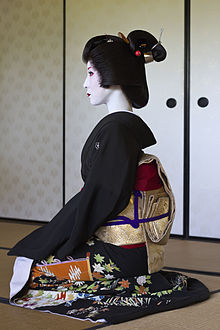
| Part of a series on the |
| Culture of Japan |
|---|
 |
Geisha (芸者) (/ˈɡeɪʃə/; Japanese: [ɡeːɕa]),[1][2] also known as geiko (芸子) (in Kyoto and Kanazawa) or geigi (芸妓), are female Japanese performing artists and entertainers trained in traditional Japanese performing arts styles, such as dance, music and singing, as well as being proficient conversationalists and hosts. Their distinct appearance is characterised by long, trailing kimono, traditional hairstyles and oshiroi make-up. Geisha entertain at parties known as ozashiki, often for the entertainment of wealthy clientele, as well as performing on stage and at festivals.
The first female geisha appeared in 1751, with geisha before that time being male performers who entertained guests. Only later did the profession become mainly characterised by female workers.[3][a]
The arts that geisha perform are considered highly developed and, in some cases, unique throughout Japan to the world of geisha. For example, the Gion district of Kyoto is the only district wherein the kyo-mai style of Japanese traditional dance is taught. This style of dance is taught solely to the geisha within the district by the Inoue school, with the school's former head, Inoue Yachiyo, having been classified as a "Living National Treasure" by the Government of Japan, the highest artistic award attainable in the country, in 1955.[5]
- ^ "How to pronounce geisha". forvo.com. Forvo Media. Retrieved 1 June 2020.
- ^ "English geisha translations". ezglot.com. E-Z-Glot. Retrieved 1 June 2020.
- ^ "Discover the Unknown World of Male Geishas". 5 January 2018.
- ^ Crihfield 1976, p. 42–43.
- ^ Crihfield 1976, p. 30.
Cite error: There are <ref group=lower-alpha> tags or {{efn}} templates on this page, but the references will not show without a {{reflist|group=lower-alpha}} template or {{notelist}} template (see the help page).